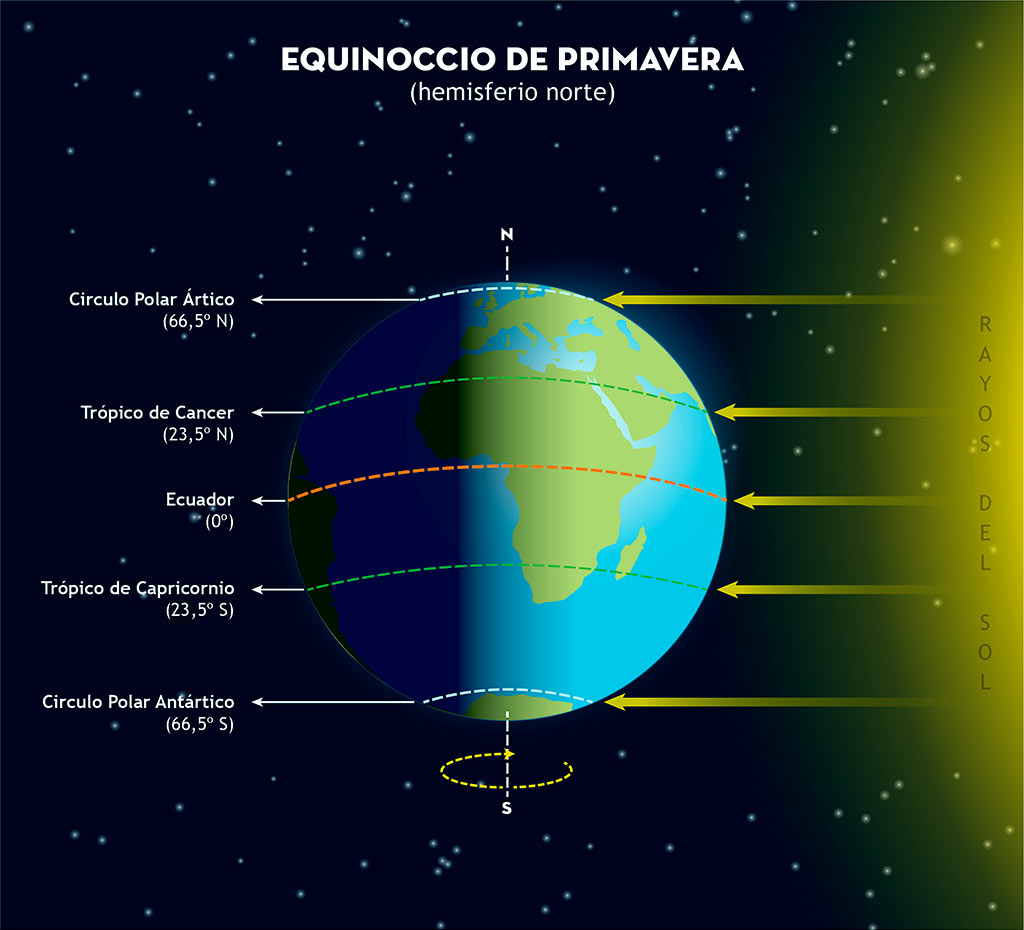Spring
The beginning of spring
Spring 2025 in the northern hemisphere will begin on March 20 at 10:02 hours official Spanish mainland time according to calculations by the National Astronomical Observatory (National Geographic Institute - Ministry of Transport and Sustainable Mobility). This season will last approximately 92 days and 18 hours, and will end on June 21 with the beginning of summer.
The beginning of spring in the northern hemisphere is defined by the moment when the Earth passes through the point in its orbit from which the centre of the Sun crosses the celestial equator in its apparent northward motion. On the day when this happens the length of day and night practically coincide. This is also called the vernal equinox.
As spring begins in the northern hemisphere, autumn begins in the southern hemisphere.
The sky during spring 2025
The sky after sunset will begin the season with Mars and Jupiter visible, but the second will disappear at the beginning of June, when Mercury will appear in the evening sky.
Sunrises, on the other hand, will begin spring without any visible planet. Venus will begin to be visible from late March, and in the beginning of April, Saturn and Mercury will appear. Mercury will stop to be visible in late May.
As for constellations, in the early spring some typical winter constellations, such as Orion, Canis Major and Gemini, will still be visible at dusk. As the weeks progress, these constellations will move closer to the Sun and give way to more characteristic spring constellations, such as Leo, with its striking inverted question mark shape ending in the star Regulus, Virgo, with the bright Spica, and the Bootes, with the red star Arcturus.
The eclipse will take place on 29 March, it which will be visible from the northwest of Europe, Russia and Africa, Greenland, and the northeastern end of America. It will be possible to see it from Spain with mid-low magnitudes.
Other phenomena of astronomical interest during the spring of 2025 are the Lyrid meteor showers, whose maximum is expected around April 22, and the Eta aquarids, with a maximum around 5 May. The full moons of the season will occur on May 6. The full moons of the season will occur on April 13, May 12, and June 11.
Time change
Although both the European Parliament and the Commission have spoken out in favour of eliminating time changes in the future, there is still no final decision on the matter. Therefore, the traditional time change on the last Sunday in March will remain in place for 2025. On that day, March 31 , at 2:00 a.m. Spanish mainland time, the clocks will be set forward one hour to 3:00 a.m. In the Canary Islands, 1:00 a.m. will be changed to 2:00 a.m.
Some interesting facts about spring
Throughout the 21st century, the start of spring can occur on at most three different calendar dates (19, 20 and 21 March), with the earliest start being in 2096 and the latest start in 2003. The variations from year to year are due to the way the sequence of calendar years (some leap years, some not) fits with the length of each orbit of the Earth around the Sun.
Early spring is the time of year when day length increases most rapidly. At Spanish mainland latitudes, the sun rises more than a minute earlier in the morning than the previous day, and sets more than a minute later in the evening. As a result, in early spring, the time the Sun is above the horizon increases by almost three minutes each day.
For more information on the year's astronomical phenomena, please consult the Almanak of the Astronomical Observatory, , published by the National Geographic Institute.
Information provided by the National Astronomical Observatory (IGN, Ministry of Transport and Sustainable Mobility). Reproduction in whole or in part is authorised provided the source is acknowledged.

